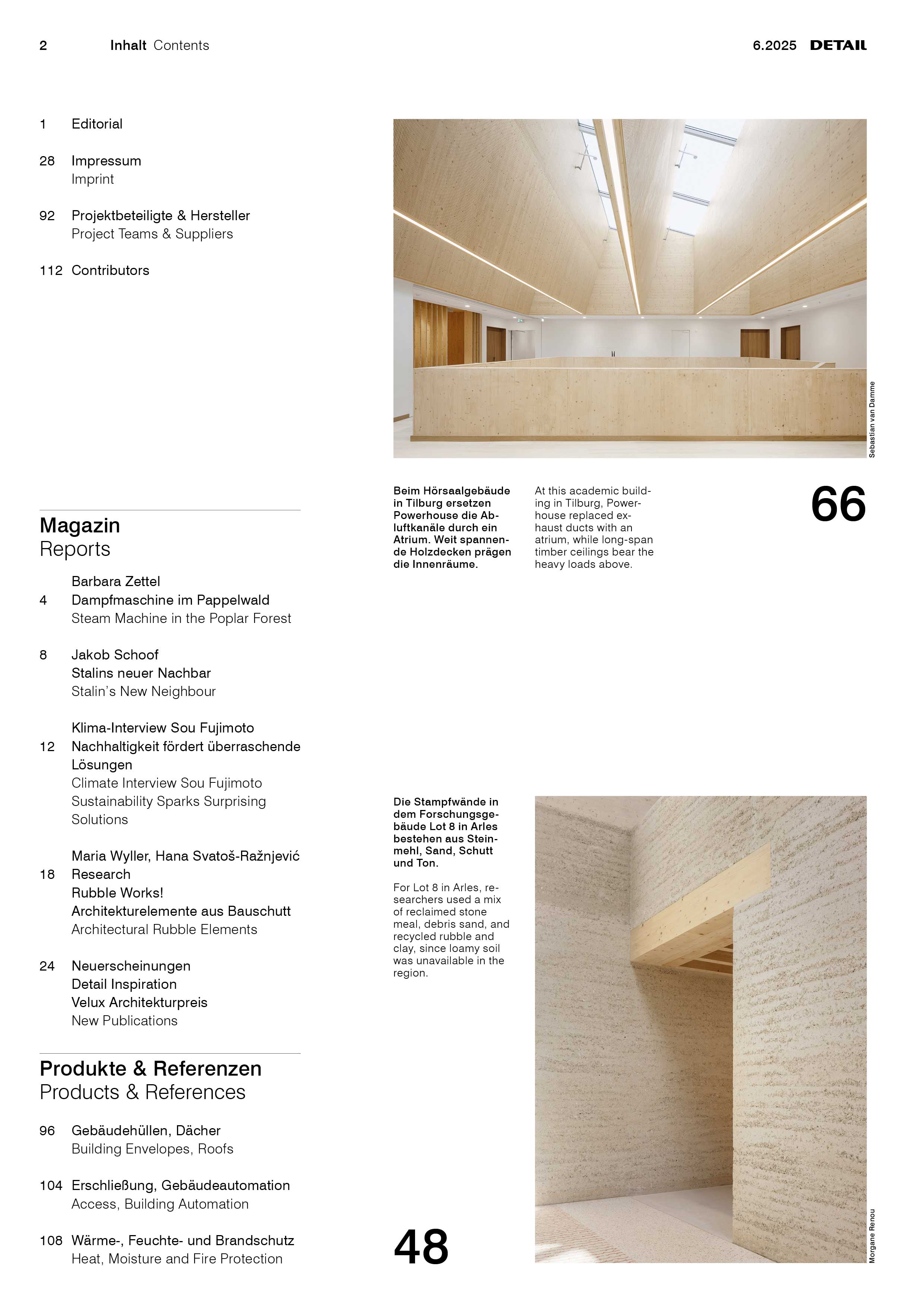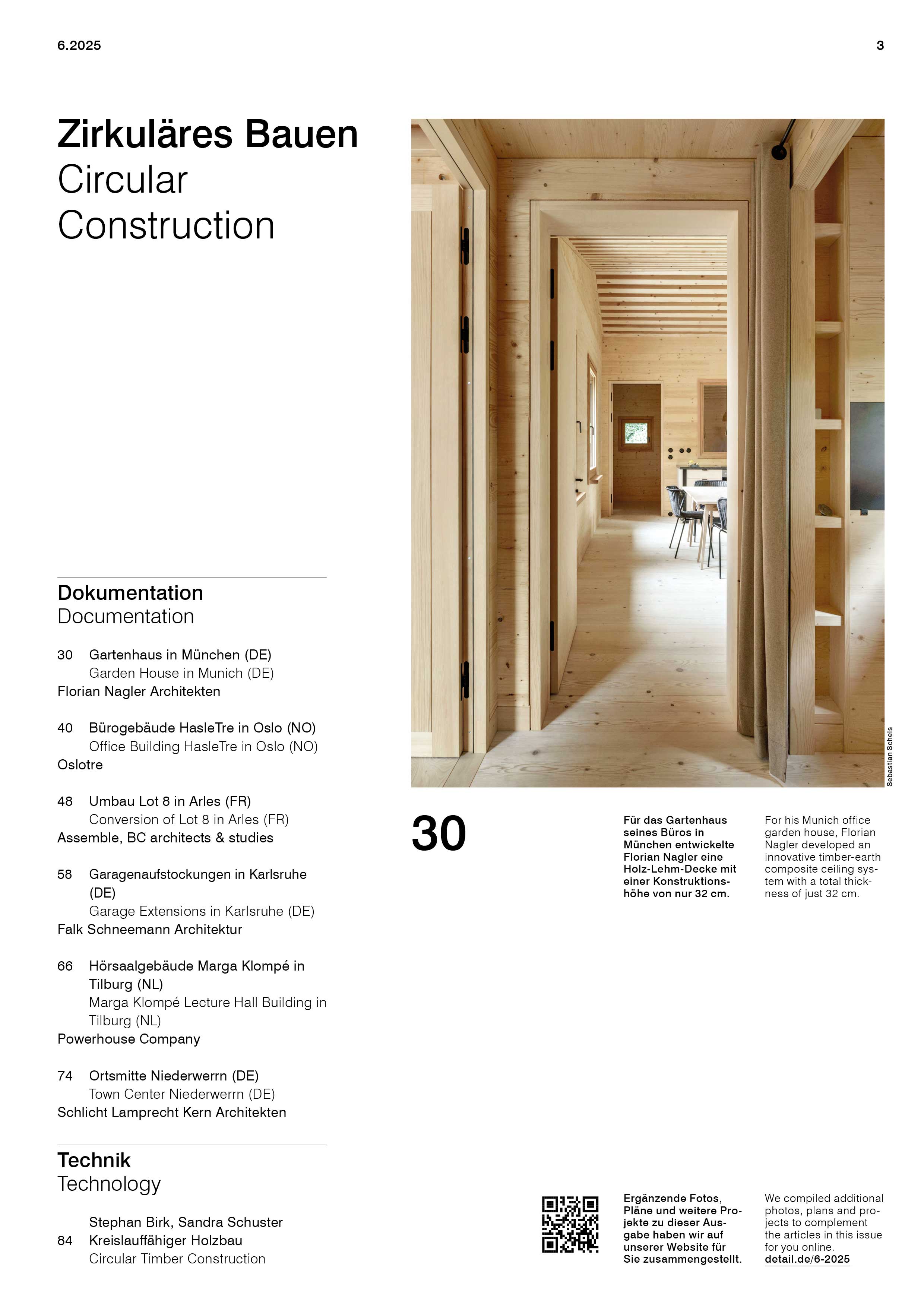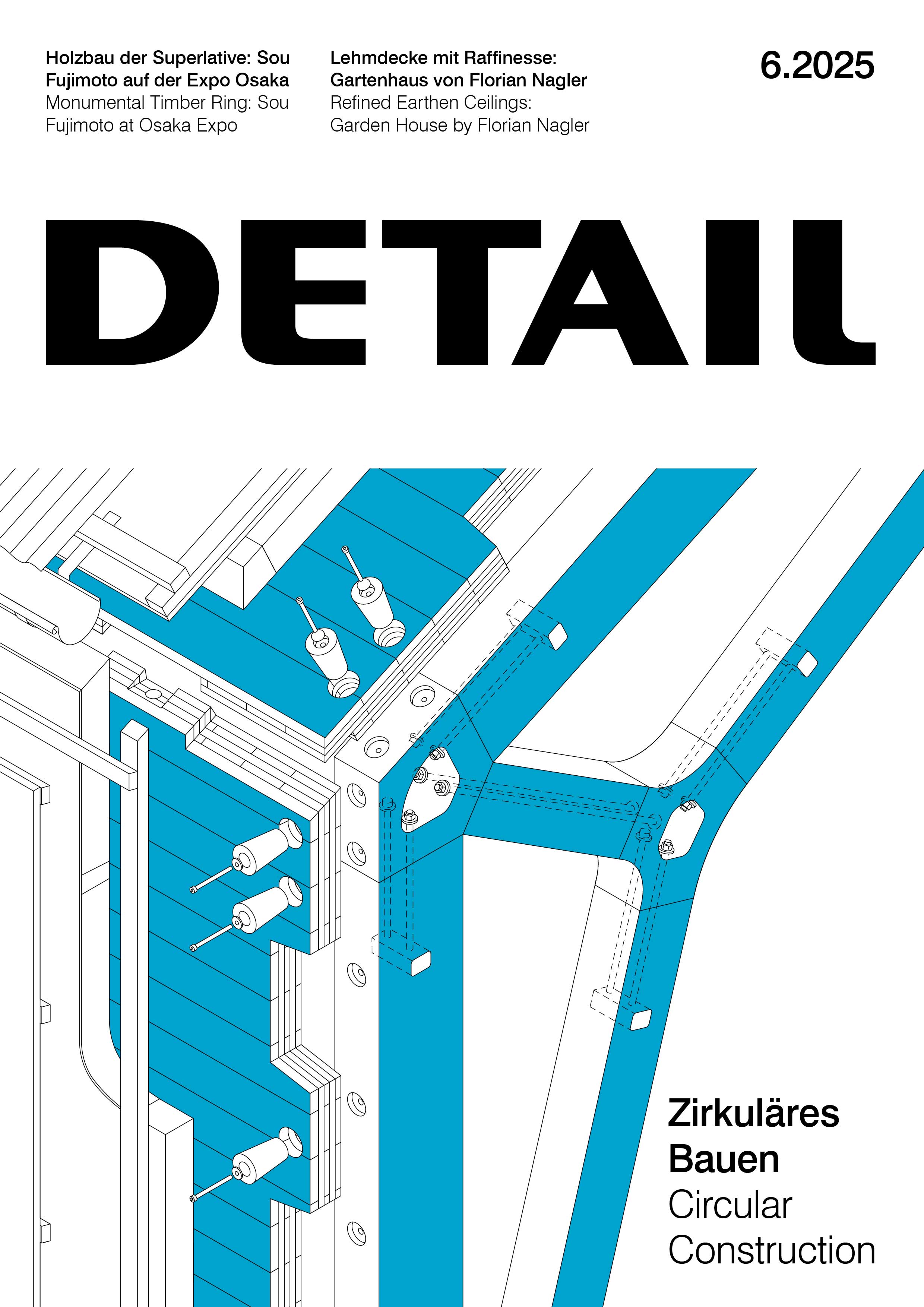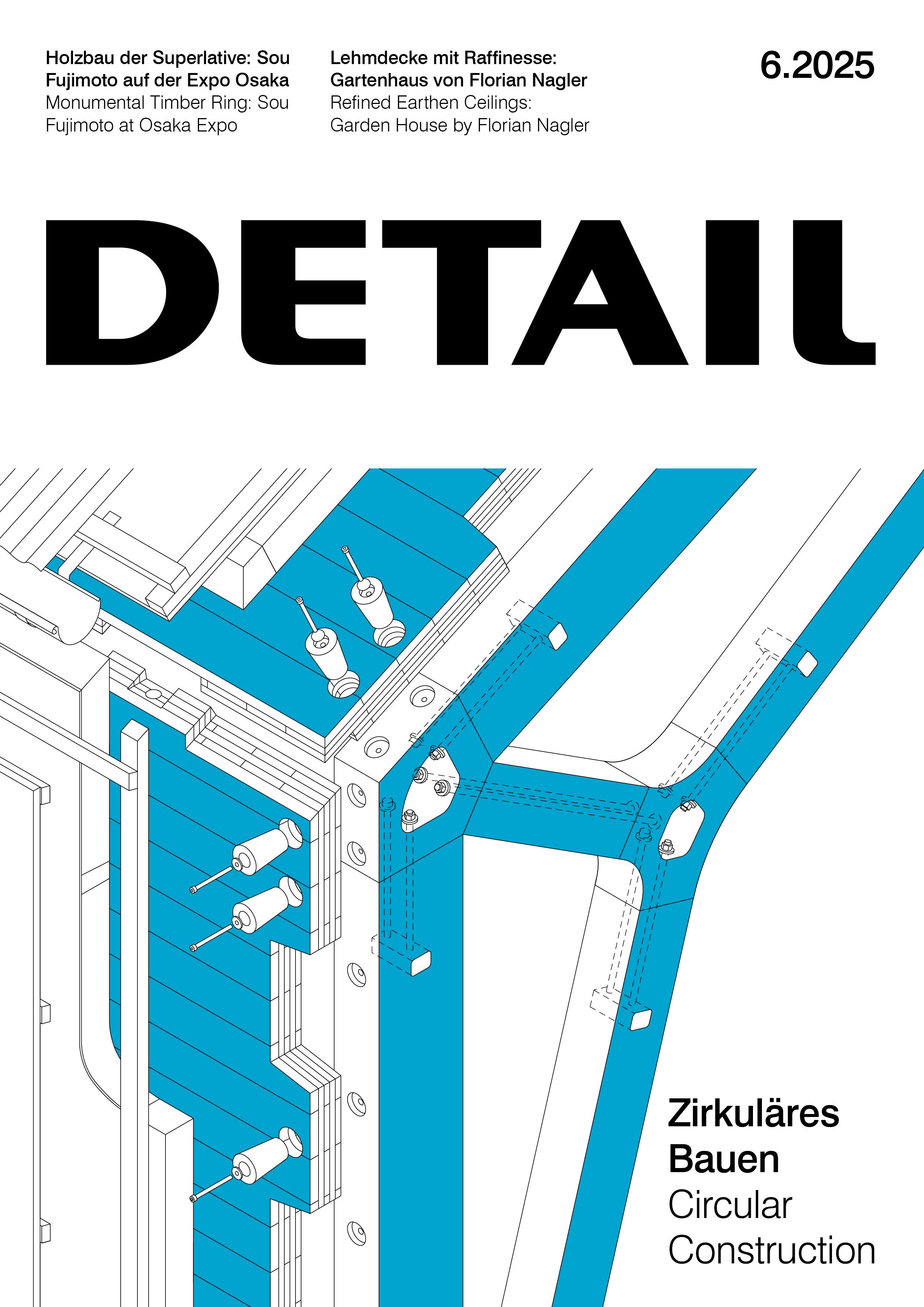Circular Construction
When researching circular construction, one encounters a wealth of innovative approaches – alongside numerous obstacles. Today, few architecture or engineering practices can avoid the topic, yet only a handful of projects truly meet its demands. Doing full justice to the concept might require looking back to traditional buildings or practices from other cultures. Even the most promising ideas often stumble due to costs, performance requirements, or regulatory constraints.
The cradle-to-cradle principle envisions buildings returning to the natural cycle after use. In practice, however, most are only partially composed of natural or compostable materials. One notable exception is Florian Nagler’s Garden House, winner of the Detail Award, which closely follows this principle. Another route is the reuse or refurbishment of components from demolished buildings. But this, too, is complex – components are often scarce and costly to extract and and make fit for new applications.
To facilitate recycling, some structures are being designed for disassembly. Yet even timber joints fixed with screws can prove difficult to undo after years in place. A research group in Arles sees itself as a recycler of remnants, developing new materials from construction debris and agricultural waste: sunflower stalks become acoustic panels, while rice straw from cultivation is turned into insulation. The team also experiments with local resources: in nearby salt pans, salt crystallises on metal racks to form tiles, while algae are used to make lamps, vases, and wall finishes. Architecture made from rubble, clad in salt, rice, and seaweed – a compelling vision of the future. Perhaps the most promising path lies in combining these diverse strategies. Sabine Drey




Projects in this Issue
-

Recycled concrete meets regional building culture
Community Centre in Niederwerrn
Designed by Schlicht Lamprecht Kern Architekten, the community centre combines structural and social sustainability. Two new buildings made of wood and recycled concrete have been added to the two existing buildings to create a meeting place.
-

Stalin’s new neighbour
The Museum of Modern Art in Warsaw
Designed by Thomas Phifer, the National Museum of Modern Art in Warsaw is a building that demands a second look. Behind its smooth white concrete facade, an astonishingly light and diverse interior opens up.
-

Immersive pavilion structures and circular concepts
Expo Osaka 2025 – the Future of Our Society
Under the theme “Designing Future Society for Our Lives“, architects such as LAVA, Nüssli, Foster + Partners, Kengo Kuma, Shigeru Ban and Nikken Sekkei are impressing visitors to this year's Expo in Osaka with futuristic and sustainable pavilion structures.
-

Jeans as insulation
Marga Klompé Building in Tilburg by Powerhouse Company
Europe's first lecture hall to be constructed entirely from solid wood has been built in Tilburg, the Netherlands. In keeping with its neighbours, however, the new building is clad in a shell limestonel facade.
-

Circular and relocatable housing construction
Garage Extension by Falk Schneemann Architecture
With garage extensions, Falk Schneemann Architektur creates twelve new apartments in the Karlsruhe Rintheim housing estate by means of circular densification.
Further Contributions on the Topic
-

Circular building
Co-Operative Building in Frankfurt am Main by DGJ
A colourful glass facade wraps around DGJ Architektur's cooperative housing near Frankfurt city centre. It serves as an eye-catcher and an effective soundproofing facade for the day-care centre and the residents.
-

Continuation of the story
Residential and Studio Building near Berlin
In the Barnim district, Christoph Wagner Architekten (CWA) in collaboration with Wenke Schladitz have converted a Mark Brandenburg farmhouse into a residential building with a goldsmith's studio, preserving the existing layers of history.
-

Sustainable conversion
Multifunctional Residential Building in Brussels by Hé!
Future living – what could it look like? With its conversion of an old industrial building in Brussels, Hé! shows how sustainability, flexibility, and maximum living comfort can be combined.
-

Revitalised laboratory building
University Building in Enschede by Civic Architects
Civic Architects have imaginatively adapted the Langezijds laboratory building, dating from 1972, for the Institute of Geoinformation at the University of Twente in Enschede in the Netherlands.
-

R-concrete with crushed brick aggregate
Rehabilitation of a Residential Building in Versailles by ADT
Architectural interventions in R-concrete lend a house rehabilitated by Atelier Delalande Tabourin in Versailles its distinctive character.
-

Collective living
Residential Building near Paris by Plan Común
The Parisian architectural studio Plan Común developed at its own behest a residential building featuring spacious communal areas. The project is an experiment in co-living in a housing community.
Previous Issues
-

Facades 5.2025
The facade is a building’s most outward-facing element. The projects featured in this issue reveal the diverse ways architecture firms approach the art of cladding
-

Solid Construction 4.2025
Around 75 % of residential buildings in Germany are made of masonry. This enduring preference reflects growing confidence in solid construction and provides the impetus for dedicating this issue of Detail to the topic.
-

Urban Housing 3.2025
Building plots are becoming scarce, housing costs are soaring, and apartments in new developments are shrinking. The model has shifted from suburban houses to urban living. But what does that mean?
-

Digital and Sustainable 1-2.2025
What lies ahead for architecture in the digital age? To gain insight, we surveyed architects from around the globe on the role of artificial intelligence. The result is a fascinating snapshot of their perspectives.
-

Masonry 12.2024
In addition to the winning projects of the Detail Award, our December issue takes us to masonry buildings in France and southern England and to Danish brick construction.
-

Timber Construction + Prefabrication 11.2024
From residential estates and office complexes to an observation tower and an Olympic milestone in Paris, this issue showcases the versatility of timber construction through seven exemplary projects.
-

Building Envelopes 10.2024
While many new residential buildings are generic investor projects using cheap materials, Paris continues to lead with experimental milestones in the use of natural building materials. We present these building envelopes in this issue.
-

New Work 9.2024
New Work is a widely used term these days, but its meaning often remains unclear. In this concept edition of Detail, we let current projects illustrate these changes rather than providing rigid definitions.
-

Building in the Mountains 7/8.2024
From the metropolis to the solitude of the mountains: In our summer issue, we explore two highly contrasting subjects. The Olympic Games in Paris and Building in the Mountains.
-

Climate and Resources 6.2024
Sustainability encompasses various practices, all aimed at reducing carbon emissions. With this June issue, we spotlight six diverse projects that are taking steps towards a climate-neutral future in very different ways.
-

New Housing in Old Stock 5.2024
The focus should be on developing housing within existing buildings and settlementstructures – through conversions, additions, extensions, and densification. Our new issue illustrates how this can be achieved.
-

Balconies, Loggias, Terraces 4.2024
Out into the open! Our April issue delves into the construction and design of buildings with balconies, terraces, loggias, and arcades. We hope you enjoy exploring these features.
-

Schools 3.2024
Is it possible to reduce costs and guarantee quality simultaneously in construction? As we embark on the new year, we confront a pressing issue that will accompany us for some time to come.
-

Simple + Cost-Efficient 1/2.2024
Is it possible to reduce costs and guarantee quality simultaneously in construction? As we embark on the new year, we confront a pressing issue that will accompany us for some time to come.
-

Increasing Density 12.2023
This December issue is dedicated to urban density and the architectural solutions needed to achieve it. While we understand the necessity of densification, few are eager to sacrifice their own space.
-

Natural Building Materials 11.2023
In the last decade, timber construction has rapidly gained ground in the building industry. Our current issue documents multi-layered examples of the detailed application of natural building materials.
-

Windows and Facades 10.2023
Facades have always had many roles to play. They give buildings a face, protect them from the elements, and convey meaning. The examples presented in this issue highlight the merits of thoughtful facades.
-

Mixed Use 9.2023
We selected exciting projects for our September issue, focussing on mixed use concepts. They include residential and office spaces, sports halls and gastronomic functions and many more within their complex programs.
-

Saving Space 7/8.2023
Space is a type of resource we bring to light in this summer edition of Detail. Our Documentation section features innovative structures that make clever use of limited space.
-

Architecture and Climate Protection 6.2023
Anyone asking the inevitable question about climate protection in architecture today will receive not one but many answers.
-

Truth to Materials 4.2023
Debates about building materials in architecture inevitably mention the term “truth to materials” (known in German as “Materialgerechtigkeit”).
-

Hotels, Hostels, Guesthouses 3.2023
Few sectors of the economy were so battered during the corona years as the hotel industry.
-

Taking Stock 1/2.2023
Not only in Germany and Europe but also worldwide, building in existing structures is currently gaining in acceptance and relevance.
-

Building Envelopes 12.2022
While compiling our personal favourites of the year in the Detail editorial office, I was surprised at the vast scope of projects my colleagues had experienced in 2022. For this issue’s review of the year, they describe their architectural observations in places like Jerusalem, Berlin, and Montagnana, Italy.
-

Circular Economy 11.2022
If the aim is net zero, demolition and landfill disposal must be avoided at all costs. Today, a progressive architecture is one that takes part in the circular economy and reuses building materials.
-

Lighting Interiors 10.2022
Our October issue is all about light and interiors. PPAG’s school in Vienna brings daylight into deep cluster spaces to foster daily well-being.
-

Cultural Buildings 9.2022
In 1997, the Guggenheim Museum opened in Bilbao, and Frank Gehry’s eccentric new building transformed the Basque city into an overnight hotspot for international tourism.
-

Urban Green 7/8.2022
Especially in big dense cities, roofs and facades are the only places left to make things greener.
-

Simple and Affordable 6.2022
“Doing away with everything superfluous creates the potential for an architectural quality all of its own,” says Florian Nagler about “simple building” in an interview with Frank Kaltenbach.
-

Prefabrication Modular Construction 5.2022
Naturstein und Hochlochziegel, Ortbeton und Stampflehm in vorproduzierten Elementen: Für die Massivbauweise kommen viele unterschiedliche Materialien in Frage, und oft ist ihre Anwendung regional motiviert.
-

Solid Construction 4.2022
Natural stone and perforated bricks, cast-in-place concrete, and rammed earth in prefabricated elements – these are just a few of the diverse materials used in solid construction, and their use is often regionally motivated.
-

Urban Housing 3.2022
“A villa in the countryside with a large terrace, in front of you the Baltic Sea, Friedrichstrasse behind you …”. Thus begins Kurt Tucholsky’s 1927 poem, “The Ideal”. While Tucholsky’s ideal of urban life might be unattainable in Berlin, there are cities where it has become a reality.




